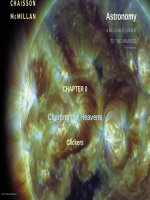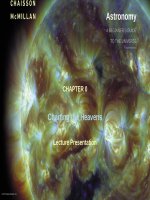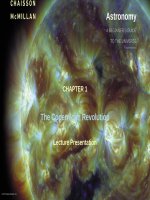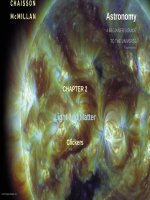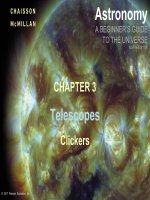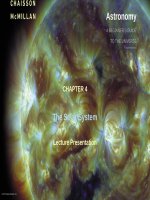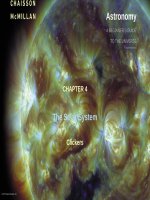Astronomy a beginners guide to the universe 8th CHaisson mcmillan chapter 11
Bạn đang xem bản rút gọn của tài liệu. Xem và tải ngay bản đầy đủ của tài liệu tại đây (4.5 MB, 39 trang )
Astronomy
A BEGINNER’S GUIDE
TO THE UNIVERSE
EIGHTH EDITION
CHAPTER 11
The Interstellar Medium
Lecture Presentation
© 2017 Pearson Education, Inc.
Chapter 11 The Interstellar Medium
© 2017 Pearson Education, Inc.
Units of Chapter 11
•
•
•
•
•
•
•
Interstellar Matter
Star-Forming Regions
Dark Dust Clouds
Formation of Stars Like the Sun
Stars of Other Masses
Star Clusters
Summary of Chapter 11
© 2017 Pearson Education, Inc.
11.1 Interstellar Matter
•
•
The interstellar medium consists of gas and dust.
Gas is atoms and small molecules, mostly hydrogen
and helium.
–
Dust is more like soot or smoke, larger clumps of
particles.
–
Dust absorbs light and
reddens light that gets through.
–
This image shows distinct reddening of stars near the
edge of the dust cloud.
© 2017 Pearson Education, Inc.
11.1 Interstellar Matter
•
Dust clouds absorb blue light preferentially;
spectral lines do not shift.
© 2017 Pearson Education, Inc.
11.2 Star-Forming Regions
•
This is the central section of the Milky Way Galaxy, showing several nebulae, areas of star
formation.
© 2017 Pearson Education, Inc.
11.2 Star-Forming Regions
•
These nebulae are very large and have very low density; their size means that their
masses are large despite the low density.
© 2017 Pearson Education, Inc.
11.2 Star-Forming Regions
•
Nebula is a general term used for fuzzy
objects in the sky.
–
–
Dark nebula: dust cloud
Emission nebula: glows, due to hot
stars
–
Reflection nebula: light from imbedded
star bounces off of cloud particles
© 2017 Pearson Education, Inc.
11.2 Star-Forming Regions
•
•
Emission nebulae generally glow red—this is the Hα line of hydrogen.
The dust lanes visible in Figure 11.7 are part of the nebula, and are not due to intervening
clouds.
© 2017 Pearson Education, Inc.
11.2 Star-Forming Regions
•
How nebulae work
© 2017 Pearson Education, Inc.
11.2 Star-Forming Regions
•
There is a strong interaction
between the nebula and the stars
within it; the fuzzy areas near the
pillars are due to photoevaporation.
© 2017 Pearson Education, Inc.
11.2 Star-Forming Regions
•
Emission nebulae are made of hot, thin gas, which exhibits distinct emission lines.
© 2017 Pearson Education, Inc.
11.3 Dark Dust Clouds
•
Average temperature of dark dust clouds is a few tens
of kelvins.
•
These clouds absorb visible light (a), and emit radio
wavelengths (b).
© 2017 Pearson Education, Inc.
11.3 Dark Dust Clouds
•
The central portion of this cloud is very dark
and can be seen only by its obscuration of the background stars. Nearby are reflection and
emission nebulae; M4 is a globular star cluster.
© 2017 Pearson Education, Inc.
11.3 Dark Dust Clouds
•
The Horsehead Nebula is a particularly distinctive dark dust cloud.
© 2017 Pearson Education, Inc.
11.3 Dark Dust Clouds
•
Interstellar gas emits low-energy radiation due to a transition in the hydrogen atom.
© 2017 Pearson Education, Inc.
11.3 Dark Dust Clouds
•
This is a contour map of H2CO near the M20
Nebula. Other molecules that can be useful
for mapping out these clouds are carbon
dioxide and water.
–
Here, the red and green lines correspond to
different rotational transitions.
© 2017 Pearson Education, Inc.
11.3 Dark Dust Clouds
•
These are carbon monoxide–emitting clouds in the outer Milky Way, probably
corresponding to regions of star formation.
© 2017 Pearson Education, Inc.
11.4 The Formation of Stars Like the Sun
•
Star formation happens when part of a dust cloud begins to contract under its own
gravitational force; as it collapses, the center becomes hotter and hotter until nuclear
fusion begins in the core.
© 2017 Pearson Education, Inc.
11.4 The Formation of Stars Like the Sun
•
When looking at just a few atoms, the gravitational force is nowhere near strong enough to
overcome the random thermal motion.
© 2017 Pearson Education, Inc.
11.4 The Formation of Stars Like the Sun
•
Stars go through a number of stages in the process of forming from an interstellar cloud.
© 2017 Pearson Education, Inc.
11.4 The Formation of Stars Like the Sun
•
Stage 1:
–
Interstellar cloud starts to contract, probably triggered by shock or pressure wave from a
nearby star. As it contracts, the cloud fragments into smaller pieces.
© 2017 Pearson Education, Inc.
11.4 The Formation of Stars Like the Sun
•
Stage 2:
–
Individual cloud fragments begin to collapse. Once the density is high enough, there is no
further fragmentation.
•
Stage 3:
–
The interior of the fragment has begun heating and is about 10,000 K.
© 2017 Pearson Education, Inc.
11.4 The Formation of Stars Like the Sun
•
The Orion Nebula is thought to contain interstellar clouds in the process of condensing, as
well as protostars.
© 2017 Pearson Education, Inc.
11.4 The Formation of Stars Like the Sun
•
Stage 4:
–
The core of the cloud is now a
protostar and makes its first
appearance on the H–R diagram.
© 2017 Pearson Education, Inc.
